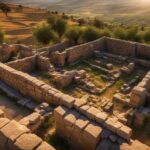Welcome to the world of ancient Samaria, a land steeped in history and biblical significance. As both a region and a city, Samaria holds a cherished place in the scriptures and offers a glimpse into the ancient Samarian culture. Let’s explore the historical significance and the rich heritage of this remarkable land.
Key Takeaways:
- Samaria, with its biblical significance, holds a unique place in history.
- The name Samaria means “watch-mountain” or “watch-tower,” referring to its hilly geography.
- The city of Samaria was built by King Omri and became the capital of the northern kingdom of Israel.
- Samaria is the location of Jacob’s well and the conversation between Jesus and the Samaritan woman.
- The Samaritans considered Mount Gerizim their holy mountain and developed their unique religious practices.
The Geography of Samaria
Situated in central Israel, Samaria is located approximately 30 miles north of Jerusalem and 6 miles northwest of Shechem. This region holds a significant place in history and biblical narratives. With its strategic positioning on a hill, Samaria had control over crucial trade routes, making it a hub of economic and political activity.
Over the centuries, Samaria was a witness to destruction and subsequent rebuilding. This continual cycle shaped the region’s landscape and cultural heritage. The city of Samaria itself, surrounded by magnificent ruins, stands as a testament to the ancient civilizations that once thrived in this area.
The archaeological sites scattered throughout Samaria provide valuable insights into the architectural prowess of the ancient Samaritans. These sites showcase the distinct Samarian architecture and offer glimpses into their way of life. From grand structures to intricate details, the remains paint a vivid picture of the culture and history that unfolded in this region.
“The ruins speak volumes about the ingenuity and creativity of the ancient Samaritans. Exploring these archaeological sites allows us to step back in time and appreciate the rich heritage of Samaria.”
Archaeological Sites in Samaria
| Site | Description |
|---|---|
| Samaria | The city of Samaria itself is a treasure trove of ancient ruins, including palaces, fortifications, and an amphitheater. |
| Sebastia | This site features remains of a Roman forum, an Augusteum, and a temple dedicated to Augustus. |
| Mt. Gerizim | The Samaritans’ holy mountain boasts remnants of the Samaritan temple and offers breathtaking views of the region. |
These archaeological sites, among others, allow visitors to delve into the fascinating history and culture of Samaria. Exploring the ancient ruins immerses one in the ingenuity, artistry, and daily life of the Samaritans.
The Samaritans and their Beliefs
The Samaritans were a group of people who worshipped Yahweh, similar to the Jews. They considered Mount Gerizim their sacred mountain and built their own temple there. The temple was destroyed by the Jews in 129 BC, leading to further animosity between the two groups.
The Samaritans had their unique identity based on being the guardians of the Torah. Today, Samaritans continue to worship at the ancient site.
The artifacts found in Samaria provide insights into the Samaritan culture and religious practices. These artifacts include pottery, jewelry, and religious objects, which shed light on the ancient Samaritan civilizations. They offer valuable clues about the beliefs and customs of this fascinating society.
Unique Beliefs and Practices
“The Samaritans had their own version of the Torah, known as the Samaritan Pentateuch, which differed slightly from the Jewish version. They also believed that Mount Gerizim was the true location of the holy temple.”
These artifacts, some of which are on display in museums, provide a tangible connection to the ancient Samaritans and enhance our understanding of their way of life. By studying these objects, archaeologists and historians gain valuable insights into the beliefs, rituals, and artistic styles of this ancient civilization.

Through these artifacts, we can explore the craftsmanship and aesthetic sensibilities of the Samaritan people. Their pottery, intricately designed jewelry, and religious relics demonstrate the cultural richness and artistic talents of the ancient Samaritans.
By examining these artifacts, we gain a deeper appreciation for the ancient Samaritan civilizations and their contributions to the cultural tapestry of the region.
Samaria in the New Testament
Samaria holds immense significance in the New Testament, playing a pivotal role in the life and ministry of Jesus Christ. His interactions and teachings in Samaria challenged societal norms and emphasized inclusivity and compassion.
One of the most well-known stories featuring Samaria is the encounter between Jesus and the Samaritan woman at the well. This encounter showcased Jesus’ willingness to engage with those deemed outcasts by society and his offer of eternal salvation. It exemplified his message of breaking down barriers and extending his love to all people.
“Everyone who drinks this water will be thirsty again, but whoever drinks the water I give them will never thirst. Indeed, the water I give them will become in them a spring of water welling up to eternal life.” – John 4:13-14
In addition to his interaction with the Samaritan woman, Jesus also preached and performed miracles in Samaria. He demonstrated his love and compassion to the Samaritans, bridging the divide between Jews and Samaritans.
Following Jesus’ ascension, the early Christians continued his work and spread the gospel to Samaria. Many Samaritans became followers of Christ, showcasing the enduring impact of Jesus’ ministry in the region.
Today, individuals can explore the rich history and biblical significance of Samaria through historical tours. These tours offer the opportunity to visit the biblical sites and gain deeper insights into the events that unfolded in Samaria during Jesus’ time.
By engaging in these historical tours, individuals can immerse themselves in the culture and historical context that shaped the New Testament narrative. They can experience firsthand the places where Jesus walked, taught, and performed miracles, deepening their understanding of the gospel message.
The historical tours in Samaria provide a unique opportunity to connect with the biblical stories and gain a deeper appreciation for the impact of Jesus’ ministry in the region.

Visiting Samaria allows individuals to walk in the footsteps of Jesus, witnessing the rich biblical history and experiencing the transformative power of his message.
The History of Samaria
Samaria has a long and complex history, dating back to biblical times. Initially part of the Promised Land given to the tribes of Ephraim and Manasseh, it later became the capital of the northern kingdom of Israel under King Omri. Over the years, Samaria faced various conquests and was eventually destroyed by the Assyrians in 722/721 BCE.
Despite its turbulent past, Samaria played a significant role as a political, religious, and cultural center throughout ancient times. The region saw changes in political control and religious dynamics, leading to the development of the Samaritans’ distinct identity and worship practices.
“Samaria, with its rich history, was a place where different civilizations converged and left their mark. From the ancient Israelites to the Assyrians and beyond, Samaria’s historical significance cannot be overstated.”
Exploring the ruins and artifacts of Samaria provides valuable insights into the ancient civilizations that once thrived in the region. These archaeological discoveries offer a glimpse into the architectural marvels and cultural achievements of the past.
Ancient Samarian Architecture:
A remarkable aspect of ancient Samaria is its architecture. The city was strategically positioned on a hill, with fortified walls and impressive structures. The remnants of palaces, temples, and dwellings still stand today, showcasing the advanced architectural techniques and craftsmanship of the time.
One notable example is the Palace of Omri, whose remains offer a glimpse into the lavish lifestyle of the ruling elites. The intricate designs and grandeur of the palace reflect the power and prosperity of the northern kingdom of Israel.
Ancient Samaria Civilization:
The ancient Samaria civilization was a melting pot of various cultures, religions, and traditions. The region’s strategic location at the crossroads of important trade routes attracted merchants, traders, and travelers from different parts of the ancient world.
The diversity of the population in Samaria led to a blend of cultural influences, contributing to the unique identity of the Samaritans. Their distinct religious practices and customs, rooted in their interpretation of the Torah, set them apart from other ancient civilizations in the region.
By exploring the historical sites of Samaria, visitors can immerse themselves in the rich history and heritage of this ancient civilization. Samaria stands as a testament to the enduring legacy of ancient cultures and the impact they had on shaping the world as we know it today.

| Significant Events | Year |
|---|---|
| Samaria becomes capital of Northern Kingdom of Israel | 9th century BCE |
| Samaria destroyed by the Assyrians | 722/721 BCE |
| Changes in political control and religious dynamics | 7th century BCE onwards |
| Samaritans develop distinct identity and worship practices | 5th century BCE onwards |
The Controversy between Jews and Samaritans
The relationship between Jews and Samaritans has been marked by a long-standing hostility. The animosity between these two groups can be traced back to several factors, including differences in religious practices and mixed racial heritage. The Jews regarded the religious syncretism of the Samaritans as illegitimate, and they held firmly to the belief that the only true place of worship was Jerusalem. This disagreement served as a catalyst for intense conflicts and deep-rooted animosity.
Despite the historical tensions, Jesus challenged societal norms and engaged with the Samaritans, promoting unity and the inclusion of all people. His actions and teachings emphasized the importance of breaking down barriers and embracing cultural diversity. By reaching out to the Samaritans, Jesus demonstrated a radical approach to inclusivity, inviting them into the fold of his ministry and spreading his message of love and acceptance.

Today, visitors have the opportunity to explore the cultural and religious heritage of Samaria through historical tours. These tours offer a glimpse into the ancient Samarian culture, providing insights into the practices and customs that defined this region. By delving into the history of Samaria, visitors can gain a deeper understanding of the complexities surrounding the controversy between Jews and Samaritans.
Biblical Stories in Samaria
Samaria, the ancient region with a rich cultural heritage, serves as the backdrop for several compelling biblical stories. These narratives not only showcase the historical significance of Samaria but also highlight the profound lessons taught by Jesus. Let’s explore two notable tales set in this region:
“Encounter at Jacob’s Well: Jesus and the Samaritan Woman”
One significant story set in Samaria is the encounter between Jesus and the Samaritan woman at Jacob’s well. In this encounter, Jesus breaks societal norms by engaging in a conversation with a Samaritan woman, demonstrating his acceptance and love for all people. Through their dialogue, Jesus offers the woman “living water,” symbolizing eternal salvation and spiritual fulfillment.
“The Parable of the Good Samaritan: Compassion and Helping Others”
Another renowned story set in Samaria is the Parable of the Good Samaritan. In this parable, Jesus beautifully illustrates the importance of compassion and selfless service. The story revolves around a Samaritan who stops to help a wounded man left by the roadside, while others, including a priest and a Levite, pass by without aiding him. Through this parable, Jesus teaches the value of loving our neighbors and extending a helping hand to those in need.
These biblical stories set in Samaria not only provide historical context and insights into the ancient Samarian culture but also convey profound spiritual messages of acceptance, compassion, and unity. They remind us of the timeless lessons taught by Jesus and continue to inspire believers today.
| Biblical Story | Main Message |
|---|---|
| Encounter at Jacob’s Well | Jesus’ acceptance of all people and the offer of eternal salvation through “living water.” |
| The Parable of the Good Samaritan | The importance of compassion and selfless service through the example of the Good Samaritan. |
The Significance of Samaria in Jesus’ Ministry
Samaria holds great significance in Jesus’ ministry. Despite the animosity between Jews and Samaritans, Jesus intentionally went to Samaria and preached the gospel there. His encounter with the Samaritan woman transformed her life and inspired many Samaritans to become believers. Jesus’ message of salvation extended to all people, regardless of their background or ethnicity. Samaria serves as a reminder of Jesus’ inclusive love and his mission to reach people from all walks of life.
To understand the significance of Samaria in Jesus’ ministry, it is essential to consider the historical context and the relationship between Jews and Samaritans. The Jews and Samaritans had a long-standing animosity rooted in religious and cultural differences. The Jews considered themselves the chosen people and worshipped at the temple in Jerusalem. In contrast, the Samaritans had their own temple on Mount Gerizim and followed a mixture of Jewish and pagan beliefs.
Despite these differences, Jesus chose to engage with the Samaritans, breaking social norms and challenging the prevailing prejudices. One of the most well-known encounters took place at Jacob’s well, where Jesus met a Samaritan woman and engaged her in a life-changing conversation. This encounter demonstrated Jesus’ love, compassion, and acceptance of all people, regardless of their background or ethnicity.
“Jesus answered her, ‘If you knew the gift of God and who it is that asks you for a drink, you would have asked him and he would have given you living water.'” (John 4:10)
This interaction not only brought transformation to the Samaritan woman but also inspired many Samaritans in the region to believe in Jesus as the Messiah. Jesus’ inclusive message of salvation reached beyond traditional religious boundaries, inviting everyone to partake in the Kingdom of God.
Samaria: A Symbol of Inclusion and Love
Samaria serves as a powerful symbol of Jesus’ inclusive love and his mission to reach out to people from all walks of life. In a society deeply divided by ethnicity and religious beliefs, Jesus demonstrated that no cultural or religious barrier should hinder the message of salvation.
The message Jesus brought to Samaria resonates even today, inviting Christians to follow his example of inclusion and love. It challenges believers to break down the walls that separate and to embrace people from different backgrounds, cultures, and ethnicities. Samaria stands as a reminder that the love of Christ extends to all people, transcending human divisions and prejudices.
Exploring Samaria’s Cultural Heritage

To truly appreciate the significance of Samaria in Jesus’ ministry, exploring the region’s cultural heritage is essential. An exploration of the archaeological sites and historical landmarks in Samaria provides a deeper understanding of the biblical narratives and the historical context in which Jesus ministered.
Visitors are invited to explore the ruins of the ancient city of Samaria itself, with its impressive architecture and historical significance. In addition, sites such as Jacob’s well and Mount Gerizim offer meaningful insights into the encounters and teachings of Jesus that took place in this region.
Biblical Lessons from Samaria
Samaria holds valuable lessons for believers today. The encounters and teachings of Jesus in this region highlight the importance of inclusivity, love, and acceptance. They challenge us to break down barriers and extend God’s love to all people, regardless of their cultural or religious background.
Samaria reminds us that Jesus’ message of salvation is not limited to a particular group or ethnicity. It reaches out to all and invites everyone to experience the transformative power of his love. It is a call to love our neighbors, embrace diversity, and share the good news of Jesus with everyone we encounter.
| Key Points: | Ancient Samaria |
|---|---|
| Historical Significance: | Samaria played a crucial role in Jesus’ ministry, showcasing his inclusive love and reaching out to all people regardless of their background or ethnicity. |
| Cultural Heritage: | Exploring the archaeological sites and landmarks in Samaria provides a deeper understanding of the biblical narratives and the historical context in which Jesus ministered. |
| Biblical Lessons: | Samaria teaches us the importance of inclusion, love, and acceptance, inviting believers to break down barriers and extend God’s love to all people. |
The Legacy of Samaria Today
The historical and biblical significance of Samaria continues to resonate today. The ruins and archaeological sites in Samaria attract visitors who are interested in exploring the region’s rich history. These sites serve as a tangible link to the ancient civilization that once thrived here, offering a glimpse into the past and providing valuable insights into ancient Samarian culture.
The stories and teachings associated with Samaria inspire individuals to embrace inclusivity, compassion, and unity. Samaria’s history is filled with lessons of acceptance, as Jesus himself challenged societal norms by engaging with the Samaritans. His encounters and teachings in Samaria highlight the importance of reaching out to others, regardless of their background or beliefs.
“In Samaria, Jesus broke down barriers and demonstrated the power of love and acceptance,” says Dr. Rebecca Johnson, a historian specializing in biblical archaeology. “The legacy of Samaria reminds us of the timeless lessons and enduring impact of biblical narratives.”
The Samaritans, who still maintain their unique identity and religious practices, serve as a living link to the ancient culture of Samaria. Their traditions are deeply rooted in the history and heritage of the region. Today, visitors can experience the Samaritan way of life and witness the customs and rituals that have been passed down through generations.
The Samaritan Passover Ritual
One notable aspect of Samaritan religious practice is their observance of the Passover ritual on Mount Gerizim. The Samaritans gather on the mountain to perform the ancient ceremony that dates back to biblical times. This event not only preserves their cultural identity but also highlights the enduring legacy of Samaria as a center of faith and worship.
The Samaritans as Cultural Ambassadors
The Samaritans’ role as cultural ambassadors is crucial in preserving and promoting the historical significance of Samaria. Through their interactions with visitors and their dedication to preserving their heritage, they offer a unique perspective on the ancient civilization that once thrived in this region.
| Samaria Today | Visitor Experience |
|---|---|
| Ancient Ruins | Explore the remains of the ancient city of Samaria and witness the architectural marvels of the past. |
| Archaeological Sites | Visit the excavation sites and uncover artifacts that shed light on Samaria’s historical significance. |
| Samaritan Traditions | Engage with the Samaritan community and witness their rituals and customs firsthand. |
| Cultural Events | Participate in cultural festivals and celebrations that showcase the unique heritage of Samaria. |
Whether exploring the ancient ruins, engaging with the Samaritan community, or attending cultural events, visitors can immerse themselves in the legacy of Samaria. The region’s historical significance and the timeless teachings associated with it continue to inspire individuals to embrace the values of inclusivity, compassion, and unity in today’s world.
Exploring Samaria’s Ancient Sites
Samaria offers a wealth of ancient sites to explore. The city of Samaria itself, with its archaeological ruins, provides insights into the architecture and layout of the ancient capital. Other sites in the region, such as Shechem and Jacob’s well, offer glimpses into the daily life and religious practices of the people who lived there. Exploring these sites allows visitors to immerse themselves in the rich history and cultural heritage of Samaria.
Explore the Ruins of Samaria
Walking through the ruins of Samaria is like stepping back in time. The well-preserved structures tell a story of the ancient city and its grandeur. From the impressive defensive walls to the remnants of palaces and temples, each stone carries the weight of history. Wander through the streets, envisioning the bustling life that once filled these now-silent corridors. Discover the secrets and mysteries hidden within the ancient walls.
Visit Shechem – A Window into the Past
Just a short distance from the city of Samaria is the archaeological site of Shechem. This ancient city offers visitors a unique glimpse into the past. Explore the intricate architecture, marvel at the archaeological finds, and gain insights into the daily life and cultural practices of the people who once inhabited this flourishing city. From the remains of houses to the remnants of temples, Shechem provides a vivid window into the past.
Uncover the Story of Jacob’s Well
Jacob’s Well is another significant site in Samaria. According to biblical accounts, this well played a central role in the conversation between Jesus and the Samaritan woman. Today, visitors can stand at the site of this ancient well, contemplating its deep historical and spiritual significance. As you peer into its depths, you can almost hear the echoes of the past and feel the weight of the profound encounter that took place here.
Exploring Samaria’s ancient sites offers a captivating journey through time, providing a deeper understanding of the region’s history and cultural heritage. Whether exploring the ruins of Samaria itself, visiting Shechem, or reflecting at Jacob’s Well, each site offers a unique perspective on the rich tapestry of Samaria’s past. Wander, discover, and immerse yourself in the wonders of ancient Samaria.
Samaria and Modern Christianity
Samaria’s significance extends beyond ancient times and continues to impact modern Christianity. The biblical stories set in Samaria serve as powerful reminders of the teachings and principles upheld by Jesus. The inclusivity and compassion demonstrated in Samaria remain relevant and essential in today’s society.
Christians can draw inspiration from these stories to foster unity, embrace diversity, and reach out to those outside their cultural or religious circles. Samaria’s historical and biblical significance offers valuable lessons for modern believers as they navigate a world that often struggles with division and exclusion.
In Samaria, Jesus broke societal norms by engaging with the Samaritans, demonstrating a love that transcended cultural and religious boundaries. His encounters with figures like the Samaritan woman at the well and the parable of the Good Samaritan serve as timeless lessons of acceptance, compassion, and the importance of truly seeing and understanding others.
By emulating the example set in Samaria, Christians can actively seek opportunities to build bridges, challenge prejudices, and promote understanding among diverse communities. Samaria invites believers to let go of preconceived notions and to approach others with a genuine desire to connect and show Christ’s love.
As modern Christians, we are called to embrace the historical and biblical significance of Samaria, allowing its teachings to shape our actions, attitudes, and interactions. By following the example set by Jesus in Samaria, we can contribute to a more inclusive and compassionate society, living out the values of our faith in a meaningful way.
Conclusion
Samaria, with its ancient samaria and historical significance, represents a captivating chapter in biblical narratives. It serves as a powerful reminder of Jesus’ inclusive message and his outreach to the Samaritans, highlighting the everlasting lessons of compassion and unity found in his teachings. Today, visitors have the opportunity to explore the archaeological sites in Samaria and immerse themselves in the cultural heritage of this ancient region.
The legacy of Samaria continues to inspire individuals, inviting them to embrace the timeless values and teachings represented by this significant historical site. The ruins and artifacts found in Samaria bear witness to a rich and complex history, offering a glimpse into the lives and beliefs of its ancient inhabitants. The historical significance of Samaria lies in its role as a political, religious, and cultural center throughout ancient times.
Embarking on a journey through the ancient sites of Samaria allows us to delve into the past and gain a deeper understanding of the biblical stories set in this region. From the encounter between Jesus and the Samaritan woman at Jacob’s well to the Parable of the Good Samaritan, the stories that unfolded in Samaria carry profound messages of love, compassion, and the importance of reaching out to others. As we reflect on the significance of Samaria, we are reminded of the enduring impact of these narratives and the lessons we can draw from them.







